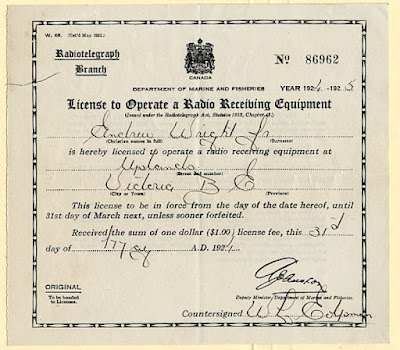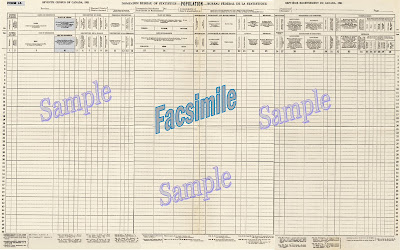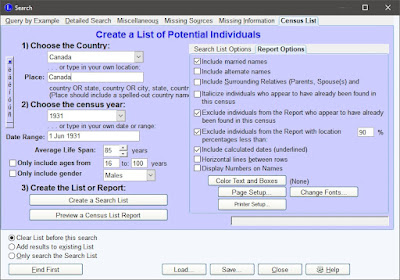It has been an interesting and challenging time for all involved with the public release of the 1931 Census of Canada by Library and Archives Canada on June 1, 2023. What started with joy and happiness quickly turned to sadness and frustration for the genealogy and family history community as issues on the Library and Archives Canada site prevented many from even trying to view the images. Yet I'm not going to harp on those issues since I've already done so in my post "1931 Census of Canada - A Release Fiasco?" Instead I'm going to share my own success stories and some tips on how I found the kin I was looking for.
My goal was to to find all four of my grandparents in this census. I knew that they were all alive and residing in Canada by the end of 1930. So, in theory, this goal should be achievable. Having a goal or task being achievable is one of the elements I mentioned in being Genealogy SMART, a post from July 2019:
- Specific: I want to find my four grandparents in the 1931 Census of Canada.
- Measurable: By the end of the process I should be able to count how many of the grandparents I have found. Hopefully all four of them.
- Achievable: Since the images of the 1931 Census of Canada have been released, I believe it should be possible to find my grandparents.
- Relevant: Finding them in the census will help me understand where they lived and how they were doing, economically, in 1931.
- Timely: The census was just released and is available for our use.
First of all, since the images of the 1931 Census of Canada aren't yet searchable by personal details such as names or street address I had to do some work ahead of time to learn exactly where they were living. I just can't plunk their names in a search engine and have the computer spit out the answers. It's going to take a bit of work on our part. The more work we do before even looking at the images should save us time in the long run.
All of my grandparents decided that they would be living in moderate to large cities in 1931 to make it a bit more challenging for me. I know that others who have also had success stories have been able to very quickly find their kin since those folks were living in rural areas or small towns and villages.
Here are family groupings for my grandparents, along with what I discovered in this step. Note that some of this information was gathered while actually in the searching for the census records. I really should have done all this work ahead of time!
- Nathanial and Winnifred (nee Warrener) McKinlay
- They were married in 1930 in Toronto
- In the 1932 city directory of London, Ontario they reside at 579 Colborne Street1
- Donald McMullen
- He had not yet married Frances Howe
- In the 1926 Census of the Prairie Provinces of Canada in the Winnipeg South Centre district he was living with his parents Louis Norman and Gertrude Anne (nee Martin) McMullen at 521 Toronto Street, Winnipeg2
- In the 1932 city directory of Winnipeg, Manitoba no Donald McMullen was found listed but his father is recorded as "McMullen L N druggist Wpg Drug h 9, 796 Wolseley"3
- Frances Howe
- She had not yet married Donald McMullen
- In the 1926 Census of the Prairie Provinces of Canada in the Winnipeg South Centre district she was living with her parents Joseph and Annie (nee Chipman) Howe at what appears to be 72 Walnut Street, Winnipeg4. However, the 1927 city directory gives their address as 72 Chestnut Street5.
- In the 1932 city directory of Winnipeg, Manitoba no Frances Howe was found but her father is recorded as "Howe Joseph E asst prof Univ Man h 72 Chestnut"6
You might notice that I reference the 1932 city directories. Most directories weren't published the same year the information was collected so I will often use the following year's directory.
Also I recorded the district (in some cases when I was getting frustrated that I couldn't find them in the 1931 Census) they we found in for the prior census closest to the 1931 Census. This might help me figure out where I should start my looking in the 1931 Census, especially when it comes to large cities.
Since I'm dealing with moderate to large cities I also used Google Maps to place each street address on a map. This became important as I worked my way through the images.
I thought I was ready to begin my search on June 1st, 2023...but the Library and Archives Canada site had another opinion. But I did have a workaround. It was a bit more work but doable.
I started with Nathaniel and Winnifred McKinlay. Based on where I found them on the map I started with the assumption that they were in the London district and not Middlesex East or Middlesex West. Via another site I had a possible lead that the address, 579 Colborne Street, might be in sub-district 17 so I started there. After scanning the eighteen pages I didn't find them.
This is where using Google Maps became useful. With 579 Colborne Street pinned on the map I had Google Maps give me directions to the first address in sub-district 17, 290 Cheapside.
 |
Screen capture from Google Maps for directions from 290 Cheapside Street to 579 Colborne Street in London, Ontario.
|
Why map the directions? As I came across the next sub-district I could put in an address from one of the pages to see if I was getting any closer to my target address. I might even jump ahead a few sub-districts and see about getting directions. By doing this I could also figure out how the sub-districts were roughly laid out.
Since I was using a workaround method which was a bit slower than just clicking the next image it did take me a bit of time. But after about 178 images I found my Dad's parents, Nathaniel and Winnifred (nee Warrener) McKinlay on page 1 in sub-district 29!
Since I'm a persistent (some may call it stubborn) researcher, I tried my luck finding my grandmother Frances Howe. This was a bit harder since I hadn't written down in my pre-search notes the district name from the 1926 Census of the Prairie Provinces of Canada yet.
This bit me big time!
I spent way too much time looking in the wrong districts because of an assumption. I first looked in Winnipeg North and Winnipeg North Centre since I assumed that the Assiniboine River would be the district boundary. But when I plotted the various address I was seeing in the sub-districts for those districts they were all too far away from 72 Chestnut Street and getting further away. That's when I clued in to look at the 1926 Census of the Prairie Provinces of Canada all thanks to a suggestion by Dave Obee in his CanGenealogy 1931 census research tips page.
They were in the Winnipeg South Centre district in 1926! Once I started getting directions from 72 Chestnut Street to addresses for the sub-districts in that district plotted on the map everything started to work out much, much better. Relatively quickly I was able to find Frances and her parents.
,%20Ward%201%20(51),%20p%207%20-%20Joseph%20E%20Howe%20household.jpg) |
| 1931 census of Canada, Winnipeg, district 189 (Winnipeg South Centre), sub-district 51 (Winnipeg Ward 1), p. 7, dwelling 58, family 59, household of Joseph Howe; RG 31; digital images, Library and Archives Canada (https://recherche-collection-search.bac-lac.gc.ca/eng/census2/index1931 : accessed 2 Jun 2023). |
It was getting late, I was tired, and I'd already had enough challenges on the launch day while also providing guidance and tips to others via several Facebook groups. So I decided to leave looking for my other grandparent, Donald McMullen, until the daylight hours of June 2nd.
At around 11 am on June 2, 2023 Ancestry released their copies received from Library and Archives Canada and posted the images in their "1931 Census of Canada" browse only collection and the game suddenly changed for me.
 |
Screen capture from Ancestry's "1931 Census of Canada" collection search page found at https://www.ancestry.ca/search/collections/62640/.
|
I didn't have to deal with a slow or non-functioning LAC site. Since Ancestry had already gone through the experience of hosting the images of the 1950 Federal Census of the United States of America I figured they could deal with any amount of traffic created by Canadian researchers.
Using all the tricks I'd learned I knew I should be able to find Donald and his parents in short order.
I decided I'd first plot both where Frances Howe, his future wife, and Donald McMullen lived since I could possibly use her address as starting point.
 |
| Screen capture from Google Maps for directions from 72 Chestnut Street to 796 Wolseley Avenue in Winnipeg, Manitoba. |
They are practically neighbours! According to the map, they were about a minute walk apart.
In just a few minutes I found the household of Donald's parents, Louis and Gertrude (nee Martin) in the next sub-district, number 52, from Frances Howe and her parents.
,%20Ward%201%20(52),%20p%2012%20-%20Louis%20McMullen%20household.jpg) |
| 1931 Census of Canada, Winnipeg, district 189 (Winnipeg South Centre), sub-district 52 (Winnipeg Ward 1), p. 12, dwelling 110, family 140, household of Louis McMullen; RG 31; digital images, Ancestry Operations, Inc., Ancestry.ca (https://www.ancestry.ca/search/collections/62640/ : accessed 2 Jun 2023). |
I had actually completed my goal of finding my grandparents in the 1931 Census of Canada.
I won't bore you with the challenges I had finding Elizabeth (nee Murdoch) McKinlay, my great-grandmother, in London, Ontario. But I can tell you that it is really, really important to be not distracted when looking at the images. I missed her at least two times!
The one I dreaded finding was the household of George Kaye and Henrietta (nee McGregor) Warrener, my great-grandparents, in Toronto. With Toronto being so large I thought it would be a near impossible task. Yet I found them in about 40 minutes (again a wrong assumption got me for about 10 minutes of that time).
I still have a few great-grandparents to find but now that I have a working method it shouldn't be to much of a challenge (I know, Murphy's Law is just waiting in the wings).
My tips to you:
- Do your searches when you won't get distracted!
- Have a plan.
- Gather as much information about where the person was living around 1931
- Use city directories for 1931 and 1932
- The 1935 Voters' Lists might help if you believe they stay in the same home since 1931
- Use the prior census to see what district and even sub-district that street or place was listed in. The person might not even be in Canada at that time but knowing the district and sub-district may help reduce the number of pages to look at in a large city.
- For a large city, make use of Google Maps to help figure out if you are getting closer to the street address you want to find
- Use the images from Ancestry. Their images load so much faster than the copies on the LAC site. Plus their filmstrip found at the bottom of their image screen makes it a breeze to move to the next sub-district
- Don't get stressed out trying to find your kin. Genealogy and family history research is supposed to be fun. You might even think about waiting until a searchable name index is available.
Good luck in your searches!
1. Vernon Directories Limited, Vernon's City of London (Ontario) Directory for the Year 1932 (Hamilton, Ontario: Vernon Directories Limited, 1932), 370, entry for McKinlay Nathnl (Winnifred).
2. 1926 Census of the Prairie Provinces of Canada, Manitoba, district 17, sub-district 19, Winnipeg, p. 29, dwelling 219, family 366, Donald McMullen; RG 31; digital images, Library and Archives Canada, Library and Archives Canada (www.bac-lac.gc.ca : accessed 30 Apr 2020); citing Library and Archives Canada microfilm T-27399.
3. Henderson Directories Limited, Henderson's Winnipeg Directory 1932 (Winnipeg, Manitoba: Henderson Directories Limited, 1932), 935, entry for McMullen L N.
4. 1926 Census of the Prairie Provinces of Canada, Manitoba, district 17, sub-district 21, Winnipeg, p. 7, dwelling 71, family 75, Frances Howe; RG 31; digital images, Library and Archives Canada, Library and Archives Canada (www.bac-lac.gc.ca : accessed 5 Jan 2021); citing Library and Archives Canada.
5. Henderson Directories Limited, Henderson's Winnipeg Directory 1927 (Winnipeg, Manitoba: Henderson Directories Limited, 1927), 943, entry for Howe Joseph E.
6. Henderson Directories Limited, Henderson's Winnipeg Directory 1932 (Winnipeg, Manitoba: Henderson Directories Limited, 1932), 817, entry for Howe Joseph E.
,%2028%20May%201931,%20p%208,%20col%204.jpg)
,%20Ward%203%20(77),%20p%205%20-%20extract%20with%20radio%20column.jpg)

,%20Grantham%20Township%20(16),%20p%201%20-%20columns%2016%20and%2017%20extracted.jpg)



,%20p%2010.jpg)
,%20Ward%204%20(29),%20p%201%20-%20Nathaniel%20and%20Winnifred%20McKinlay%20-%20Transcription.jpg)


,%20Ward%204%20(29),%20p%201%20-%20Nathaniel%20and%20WInnifred%20McKinlay.jpg)
,%20Ward%201%20(51),%20p%207%20-%20Joseph%20E%20Howe%20household.jpg)


,%20Ward%201%20(52),%20p%2012%20-%20Louis%20McMullen%20household.jpg)


![Screen capture of "Unable to open [object Object]: Error loading image at https://central-d.dev.bac-lac.gc.ca/.item/?id=e011717820&app=census1931&op=img" from the Library and Archives Canada 1931 Census search page from 10:23 p.m. ET on June 1, 2023.](https://blogger.googleusercontent.com/img/b/R29vZ2xl/AVvXsEhTGE5UXW_QA1O97mlOEEyLimWrVD2OMxeQWrA1KJDb27oCjxK_bFDjlf2NM9S48cJ9Gd2G67fzVMudC1FNF36LvjHk-mkh1_geVJldrcxYnGZUU1R9ToAOmUCjmisJi8TgA7YhPXbqE3223qKaINbVYHeF5OaRT3b2XMXk-RGfKaYnHiJpsMd3GLOg/w400-h248/LAC%20-%201931%20Census%20-%20Unable%20to%20open%20object%20error%20-%2020230601-2203.jpg)
,%20Winnipeg%20Ward%202%20(9),%20descriptive%20card.jpg)
,%20Ward%204%20(29),%20p%201%20-%20Nathaniel%20and%20WInnifred%20McKinlay.jpg)







